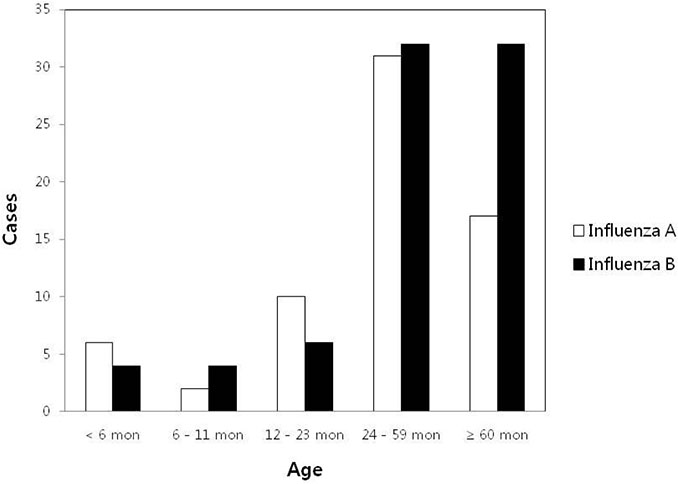Korean J Pediatr Infect Dis.
2013 Aug;20(2):89-97.
The Clinical Characteristics of Influenza B Infection during the 2011-2012 Influenza Season
- Affiliations
-
- 1Department of Pediatrics, College of Medicine, The Catholic University of Korea, Seoul, Republic of Korea. kjhan@catholic.ac.kr
Abstract
- PURPOSE
This retrospective study was performed to identify the clinical characteristics of influenza B infection and compare to influenza A infection.
METHODS
Medical records of patients diagnosed with influenza using a multiplex PCR test, admitted to Seoul St. Mary's Hospital, during the 2011-2012 influenza season were analyzed. Clinical and laboratory characteristics of influenza B patients were investigated and compared with those of influenza A patients.
RESULTS
A total of 145 influenza patients were enrolled during this study period. Among these, 66 and 78 patients were diagnosed with influenza A and B, respectively, and 1 patient was diagnosed with co-existing influenza A and B. Cough (88.2%), rhinorrhea (77.1%) and sputum (60.4%) were the most common symptoms among these influenza patients, and most were diagnosed with upper respiratory infection (31.9%) or lower respiratory infection (49.3%). In comparison to influenza A patients, influenza B patients were older (4.7+/-4.1 years vs. 3.3+/-2.5 years, P=0.016), and the number of fever days before hospitalization were longer (3.0 days vs. 2.5 days, P=0.043). While sore throat (10.3% vs. 1.5%, P=0.039) and vomiting (20.5% vs. 6.1%, P=0.012) were more common in influenza B patients than in influenza A patients, other clinical and laboratory characteristics were not significantly different between the two groups.
CONCLUSIONS
No significant differences in clinical and laboratory perspectives were manifested in influenza A and B infections. Preventive measures should be emphasized over treatment in influenza B due to prolonged fever duration before admission.
Keyword
MeSH Terms
Figure
Reference
-
1. Neuzil KM, Mellen BG, Wright PF, Mitchel EF Jr, Griffin MR. The effect of influenza on hospitalizations, outpatient visits, and courses of antibiotics in children. N Engl J Med. 2000; 342:225–231.
Article2. Thompson WW, Shay DK, Weintraub E, Brammer L, Bridges CB, Cox NJ, et al. Influenza-associated hospitalizations in the United States. JAMA. 2004; 292:1333–1340.
Article3. Kang TG, Kim MJ, Kim BG, An HS, Yun HJ, Choi EJ, et al. Comparisons of clinical features among influenza A (H1N1) and seasonal influenza A and B during 2009 to 2010 at a single institution. Pediatr Allergy Respir Dis. 2011; 21:269–276.
Article4. Kim SH, Park CH, Huh K, Shim GH, Kim HB, You SJ, et al. Comparison of clinical manifestation and laboratory findings between H1N1 and influenza B infection. Pediatr Allergy Respir Dis. 2012; 22:64–70.
Article5. Ambrose CS, Levin MJ. The rationale for quadrivalent influenza vaccines. Hum vaccin Immunother. 2012; 8:81–88.
Article6. Jian JW, Lai CT, Kuo CY, Kuo SH, Hsu LC, Chen PJ, et al. Genetic analysis and evaluation of the reassortment of influenza B viruses isolated in Taiwan during the 2004-2005 and 2006-2007 epidemics. Virus Res. 2008; 131:243–249.
Article7. Rota PA, Wallis TR, Harmon MW, Rota JS, Kendal AP, Nerome K. Cocirculation of two distinct evolutionary lineages of influenza type B virus since 1983. Virology. 1990; 175:59–68.
Article8. Roy T, Agrawal AS, Mukherjee A, Mishra AC, Chandha MS, Kaur H, et al. Surveillance and molecular characterization of human influenza B viruses during 2006-2010 revealed co-circulation of Yamagata-like and Victoria-like strains in eastern India. Infect Genet Evol. 2011; 11:1595–1601.
Article9. Korea Centers for Disease Control and Prevention. Korean influenza surveillance report, 2011-2012. Public Health Weekly Report. 2012. 5:873–881. accessed on 1 Dec 2012. Available at http://www.cdc.go.kr/CDC/info/CdcKrInfo0301.jsp?menuIds=HOME001-MNU0004-MNU0036-MNU0037.10. Daley AJ, Nallusamy R, Isaacs D. Comparison of influenza A and influenza B virus infection in hospitalized children. J Paediatr Child Health. 2000; 36:332–335.
Article11. Hite LK, Glezen WP, Demmler GJ, Munoz FM. Medically attended pediatric influenza during the resurgence of the Victoria lineage of influenza B virus. Int J Infect Dis. 2007; 11:40–47.
Article12. Peltola V, Ziegler T, Ruuskanen O. Influenza A and B virus infections in children. Clin Infect Dis. 2003; 36:299–305.
Article13. Belshe RB, Coelingh K, Ambrose CS, Woo JC, Wu X. Efficacy of live attenuated influenza vaccine in children against influenza B viruses by lineage and antigenic similarity. Vaccine. 2010; 28:2149–2156.
Article14. Frey S, Vesikari T, Szymczakiewicz-Multanowska A, Lattanzi M, Izu A, Groth N, et al. Clinical efficacy of cell culture-derived and egg-derived inactivated subunit influenza vaccines in healthy adults. Clin Infect Dis. 2010; 51:997–1004.
Article15. Jackson LA, Gaglani MJ, Keyserling HL, Balser J, Bouveret N, Fries L, et al. Safety, efficacy, and immunogenicity of an inactivated influenza vaccine in healthy adults: a randomized, placebo-controlled trial over two influenza seasons. BMC Infect Dis. 2010; 10:71.
Article16. Janjua NZ, Skowronski DM, De Serres G, Dickinson J, Crowcroft NS, Taloy M, et al. Estimates of influenza vaccine effectiveness for 2007-2008 from Canada's sentinel surveillance system: cross-protection against major and minor variants. J Infect Dis. 2012; 205:1858–1868.
Article17. Monto AS, Ohmit SE, Petrie JG, Johnson E, Truscon R, Teich E, et al. Comparative efficacy of inactivated and live attenuated influenza vaccines. N Engl J Med. 2009; 361:1260–1267.
Article18. Vesikari T, Fleming DM, Aristegui JF, Vertruyen A, Ashkenazi S, Rappaport R, et al. Safety, efficacy, and effectiveness of cold-adapted influenza vaccine-trivalent against community-acquired, culture-confirmed influenza in young children attending day care. Pediatrics. 2006; 118:2298–2312.
Article19. Lim J, Eom CS, Kim KH, Kim S, Cho B. Coverage of influenza vaccination among elderly in South Korea: A population based cross sectional analysis of the season 2004-2005. J Korean Geriatr Soc. 2009; 13:215–221.
Article20. Kee SY, Cheong HJ, Chun BC, Kim WJ. Influenza vaccination coverage rate and factors associated with vaccination in people with chronic disease. Infect Chemother. 2011; 43:406–411.
Article
- Full Text Links
- Actions
-
Cited
- CITED
-
- Close
- Share
- Similar articles
-
- Influenza A Outbreak in a Neonatal Intensive Care Unit During the 2011-2012 Influenza Season in Korea
- Did the 2009 Influenza A (H1N1) Virus Caused more Severe Infection than Seasonal Influenza during 2009 to 2010 Season?
- Influenza Vaccine
- Prevention and Treatment of Influenza
- Influenza Associated Pneumonia



